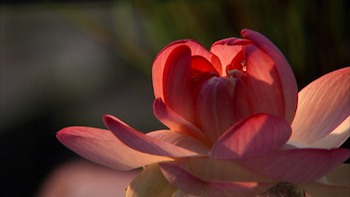- MENU
- HOME
- SEARCH
- WORLD
- MAIN
- AFRICA
- ASIA
- BALKANS
- EUROPE
- LATIN AMERICA
- MIDDLE EAST
- United Kingdom
- United States
- Argentina
- Australia
- Austria
- Benelux
- Brazil
- Canada
- China
- France
- Germany
- Greece
- Hungary
- India
- Indonesia
- Ireland
- Israel
- Italy
- Japan
- Korea
- Mexico
- New Zealand
- Pakistan
- Philippines
- Poland
- Russia
- South Africa
- Spain
- Taiwan
- Turkey
- USA
- BUSINESS
- WEALTH
- STOCKS
- TECH
- HEALTH
- LIFESTYLE
- ENTERTAINMENT
- SPORTS
- RSS
- iHaveNet.com: Home & Garden
Sean Conway

Lotus can easily be grown in backyard pond or water container
In Buddhism the lotus represents purity of body, speech and mind, floating above the muddy waters of attachment and desire -- pretty heady stuff for a plant that prefers to grow in the thick mud of shallow ponds, lakes and drainage ditches throughout greater India and other parts of Asia.
One need not travel to India to glimpse this perennial aquatic known for its magnificent, spice-scented flowers. The sacred lotus of Asia has a North American cousin that is hardy as far north as Canada. The two plants are so closely related that hybridizers have been producing exquisite crosses between the two for many years with outstanding results.
Lotuses come in three sizes: large, semi-dwarf and dwarf. They are vigorous growers, and the large varieties require a lot of space. For patio smaller spaces or and backyard water features, dwarf varieties are the way to go.
Recently, I learned how more about these exquisite plants from Richard Koogle of Lilypons Water Gardens in Adamstown, Md. Richard showed me how to create a water container for either a patio or backyard featuring a dwarf lotus. Richard brought several potted lotuses with him, but he explained that they are available from mail-order sources as dormant tubers in the early spring.
The first step is to select a container that can hold water. The lotus plant will remain in a 6-inch pot that is placed in the container of water, so the container needs to be deep enough to allow the lotus pot to sit about 4 to 5 inches below the surface of the water.
Lotuses love warm water to get growing in the spring, but as the summer progresses they prefer to sit in water that does not get hot. Richard recommended using bricks in the spring to raise the plant's pot closer to the surface where the water is warm. Then remove bricks as the season progresses and the plant starts growing.
After the lotus is positioned in the container, add one or two other aquatic plants for interest. Richard explained that aquatic marginal plants -- i.e., plants that naturally grow at the sides of ponds -- are perfect companion plants for lotus in a container. We chose a water chestnut and a corkscrew rush. These plants, also in pots, were positioned in the container alongside the dwarf lotus and propped up with bricks as well.
The next step is to add a 1-inch layer of pea gravel on top of the soil of each plant to prevent the soil from washing out of the pot and clouding up the water in the container.
Next, water is added, and -- voila! -- the perfect water garden for a small space.
Remember to build your container in place, as once the water is added it will be too heavy to move, and be sure to choose a spot with at least six hours of direct sun. Lotuses are heavy feeders, and you will need to feed your plant two to three times each month during the growing season by adding fertilizer tablets to the soil.
If your container is large enough, add a goldfish or two to keep mosquitoes from using your water garden as a maternity ward. (For smaller containers, add a few guppies.) If adding fish isn't your thing, a floating biological control called a mosquito dunk will work as well.
Availble at Amazon.com:
Ranches: Design Ideas for Renovating, Remodeling, and Building New (Updating Classic America)
AUTOS | HOBBIES | EDUCATION | FAMILY | FASHION | FOOD & RECIPES | HOME DECOR | RELATIONSHIPS | PARENTING | PETS | TRAVEL | WOMEN
Lotus Container Adds Sacred Touch to Your Garden - Gardening
Article: Copyright © Tribune Media Services